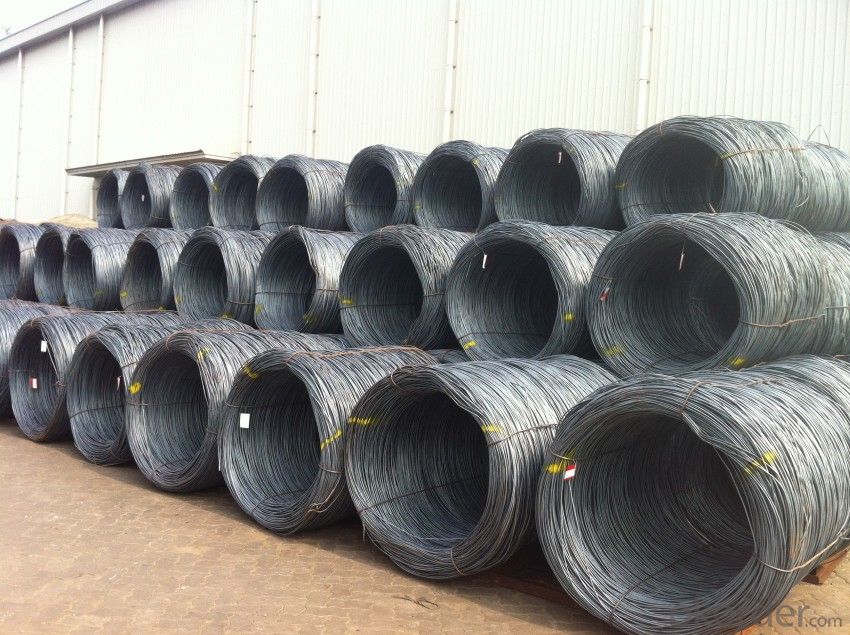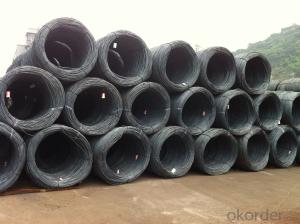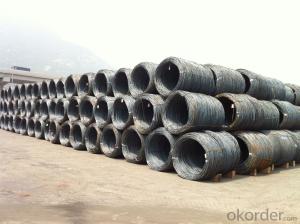Hot Rolled Steel Wire rods in Grade SAE1006-1018
- Loading Port:
- Tianjin
- Payment Terms:
- TT OR LC
- Min Order Qty:
- 25 m.t
- Supply Capability:
- 20000 m.t/month
OKorder Service Pledge
OKorder Financial Service
You Might Also Like
OKorder is offering Carbon Steel Wire Rod at great prices with worldwide shipping. Our supplier is a world-class manufacturer of steel, with our products utilized the world over. OKorder annually supplies products to European, North American and Asian markets. We provide quotations within 24 hours of receiving an inquiry and guarantee competitive prices.
Product Applications:
Carbon Steel Wire Rod are ideal for structural applications and are widely used in the construction of buildings and bridges, and the manufacturing, petrochemical, and transportation industries.After hot-rolled the products shaped into coil and delivery as finished product, including round, square, rectangular, hexagonal and so on. Since most of the products are round, it is generally called wire rod. Carbon steel wire rod is widely used in construction and manufacturing. Carbon steel wire rod is mainly used for reinforcement of reinforced concrete and welded structure or reprocessed (roberts , nail, etc.) materials, especially used to produce wire drawing, welding electrode, nails, spring, electronic, precise machinery parts and so on.
Product Advantages:
OKorder's Carbon Steel Wire Rod are durable, strong, and resist corrosion.
Main Product Features:
· Premium quality
· Prompt delivery & seaworthy packing (30 days after receiving deposit)
· Corrosion resistance
· Can be recycled and reused
· Mill test certification
· Professional Service
· Competitive pricing
Product Specifications:
Chemical Composition:
Please kindly find our chemistry of our material based on SAE1006/SAE1008 as below for your information
Grade | Chemical Composition (%) | |||||
C | Mn | S | P | Si | B | |
SAE1006 | 0.03~O.07 | 0.32max | 0.045max | 0.040max | 0.30max | 0.0008min |
Mechanical properties | ||||||
Yield strength(N/mm2) | Tensile strength(N/mm2) | Elongation (%) | ||||
250-280 | 350-380 | ≥32 | ||||
Grade | Chemical Composition (%) | |||||
C | Mn | S | P | Si | B | |
SAE1008 | 0.10max | 0.3~0.50 | 0.050max | 0.040 max | 0.15max | 0.0008 min |
Mechanical properties | ||||||
Yield strength(N/mm2) | Tensile strength(N/mm2) | Elongation (%) | ||||
≥195 | 315-430 | ≥30 | ||||
FAQ:
Q1: Why buy Materials & Equipment from OKorder.com?
A1: All products offered byOKorder.com are carefully selected from China's most reliable manufacturing enterprises. Through its ISO certifications, OKorder.com adheres to the highest standards and a commitment to supply chain safety and customer satisfaction.
Q2: What's your shipment type ?
A2: Usually we ship the goods by bulk vessel,if you want load them by container vessels,we can arrange as well .
Q3:What's your payment terms ?
A3:Mostly,we collect the money by T/T and LC at sight . We also accept time LC at 90/120 days sight.
Images:


- Q:How is steel wire rod used in the production of wire mesh partitions?
- Steel wire rod is used in the production of wire mesh partitions as it serves as the primary material for creating the wire mesh. The steel wire rod is first drawn through a series of dies to reduce its diameter and increase its length. This process creates a thin and flexible wire that can be easily woven or welded together to form the mesh structure of the partition. The wire mesh partitions provide strength, stability, and security, making them ideal for various applications such as dividing spaces, creating secure enclosures, or forming protective barriers.
- Q:How are steel wire rods used in the manufacturing of wire mesh for reinforcement?
- Steel wire rods are widely used in the manufacturing of wire mesh for reinforcement due to their exceptional strength and durability. These rods serve as the primary raw material for wire mesh production. The process begins by heating the steel wire rods to a high temperature in order to soften them. This makes it easier to shape and manipulate the rods into the desired wire mesh configuration. The softened rods are then passed through a series of dies, which gradually reduce their diameter and increase their length. This process is known as drawing, and it helps improve the mechanical properties of the wire rods, such as tensile strength and ductility. Once the wire rods have been drawn to the desired size, they are further processed through a series of specialized machines to create the wire mesh. These machines weave or weld the individual wires together, forming a grid-like pattern that is commonly used for reinforcement purposes. The wire mesh is carefully designed to provide structural support and enhance the strength of various construction materials, such as concrete. Wire mesh reinforcement is commonly used in construction projects to prevent cracking, improve load-bearing capacity, and enhance the overall durability of structures. It is extensively used in concrete slabs, walls, columns, and foundations. The steel wire rods used in the manufacturing of wire mesh provide the necessary strength and structural integrity to withstand heavy loads and resist tension forces. In summary, steel wire rods play a crucial role in the manufacturing of wire mesh for reinforcement. Their high strength, durability, and ability to be shaped make them an ideal material for creating wire mesh products. Through a series of processes, the wire rods are transformed into wire mesh that provides structural support and enhances the strength of various construction materials.
- Q:What are the different types of wire mesh for filtration made from steel wire rod?
- Wire mesh for filtration, which is made from steel wire rod, comes in various types. These include: 1. The most common and basic type is plain weave mesh. It is created by weaving the steel wire rod in a simple over-and-under pattern, resulting in a robust and sturdy mesh. Plain weave mesh is suitable for general filtration purposes. 2. Twilled weave mesh is characterized by a diagonal pattern formed by the weave. It has a higher mesh count compared to plain weave, enabling finer filtration. Twilled weave mesh is often employed in applications that require a higher level of filtration. 3. Dutch weave mesh is made by using two different wire diameters for the warp and weft wires. The warp wires are thicker, while the weft wires are thinner. This produces a tightly woven mesh with smaller openings in the weft direction, making it ideal for fine filtration applications. 4. Welded mesh is created by welding the intersecting points of the steel wire rod, resulting in a strong and durable mesh structure. It is commonly used in industrial filtration applications that require high strength and rigidity. 5. Expanded metal mesh is produced by stretching and expanding a sheet of steel wire rod, creating diamond-shaped openings. This type of mesh offers excellent strength and rigidity, making it suitable for heavy-duty filtration applications. Each type of wire mesh has unique filtration capabilities and is suitable for specific applications. The choice of wire mesh for filtration made from steel wire rod depends on factors such as the desired filtration level, strength requirements, and the specific environment in which it will be utilized.
- Q:What are the different types of steel wire rod finishes for improved wear resistance in high-temperature environments?
- There are several types of steel wire rod finishes that can enhance wear resistance in high-temperature environments. Some common options include heat treatment, such as quenching and tempering, which improves hardness and toughness. Another method is nitriding, where the surface is enriched with nitrogen to form a hard and wear-resistant layer. Additionally, coatings like ceramic or metallic coatings can be applied to provide an extra layer of protection against wear and corrosion. Overall, these finishes help to optimize the performance and durability of steel wire rods in challenging high-temperature conditions.
- Q:How is steel wire rod used in the manufacturing of wire for automotive exhaust systems?
- Steel wire rod is used in the manufacturing of wire for automotive exhaust systems as it serves as the primary material for creating the wires that make up the exhaust system. The steel wire rod is carefully shaped, formed, and welded to create the necessary components such as hangers, brackets, and supports that keep the exhaust system in place. Its strength and durability make it an ideal choice for withstanding the high temperatures and vibrations associated with automotive exhaust systems.
- Q:How is steel wire rod used in the production of wire baskets?
- Steel wire rod is used in the production of wire baskets as it serves as the primary raw material for manufacturing the wire mesh used in the baskets. The steel wire rod is processed and transformed into wires of various thicknesses and lengths, which are then woven or welded together to create the mesh structure of the basket. This ensures the strength, durability, and stability of the wire basket, making it suitable for holding and organizing various items.
- Q:How is steel wire rod used in the manufacturing of tire cords?
- Steel wire rod is used in the manufacturing of tire cords by being processed into high-tensile steel wires. These wires are then coated and twisted together to form a strong and durable cord that provides reinforcement and stability to the tire. The tire cords made from steel wire rod enhance the overall strength and resilience of the tire, making it capable of withstanding high pressures and providing better grip and control on the road.
- Q:What are the main regions for steel wire rod production?
- Asia, Europe, and North America are the primary regions where steel wire rod production takes place. In Asia, China, Japan, and India are the leading countries in steel wire rod production. China, in particular, holds the largest share of global production due to its extensive steel industry and strong domestic demand. Japan is also a significant player, known for its advanced technology and high-quality steel products. India has emerged as a major producer in recent years, driven by its expanding infrastructure and construction sectors. Europe, on the other hand, boasts prominent steel wire rod producers such as Germany, Italy, and France. Germany, with its long history of steel manufacturing, is renowned for its expertise in producing top-notch steel wire rod. Italy specializes in stainless steel wire rod production and is also a significant player in the industry. France benefits from its strategic location and serves as a hub for steel wire rod distribution throughout Europe. North America is another crucial region for steel wire rod production, with the United States and Canada playing key roles. The United States has a well-established steel industry and is known for its advanced production techniques. Canada, although not as large a producer as the United States, still makes a significant contribution to the North American market. Overall, these regions dominate global steel wire rod production and each has its own strengths and specialties. The demand for steel wire rod continues to grow, fueled by various industries such as automotive, construction, and manufacturing, ensuring a strong market for these regions.
- Q:What are the common alloying elements added to steel wire rod?
- The common alloying elements added to steel wire rod include carbon, manganese, silicon, and sometimes other elements such as chromium, nickel, and molybdenum.
- Q:How is steel wire rod used in the manufacturing of wire for musical instrument strings?
- Musical instrument strings rely on steel wire rod as a vital component in their production. This raw material, made from carbon steel renowned for its durability and strength, undergoes a series of processes to create the high-quality wire used in guitars, pianos, violins, and other instruments. To commence the manufacturing process, steel wire rod is typically heated and then rolled into thinner strands through the drawing process. This procedure refines the wire by elongating and thinning it, resulting in a more consistent and uniform diameter. Once the desired thickness is achieved, the wire undergoes heat treatments to enhance its mechanical properties. Annealing, for example, relieves stress and improves flexibility and elasticity. Following the heat treatments, the steel wire undergoes further processing to acquire the desired characteristics for musical instrument strings. Additional drawing steps may be necessary to achieve the optimal gauge or diameter specific to various instruments. Moreover, the wire can be coated with different materials to enhance its performance and durability. Nickel or stainless steel coatings can improve corrosion resistance and provide a smoother surface for playing. Finally, the wire is wound onto spools, ready to be used by musical instrument string manufacturers. These strings are meticulously crafted and assembled, utilizing the steel wire as the core material that carries tension and produces the desired pitch and tone when played. In conclusion, steel wire rod plays a crucial role in the production of musical instrument strings. Through processes such as drawing, heat treatments, and coating, this raw material is transformed into high-quality wire that meets the specific requirements of each instrument. The resulting strings provide musicians with the necessary strength, flexibility, and tonal characteristics to create beautiful music.
1. Manufacturer Overview |
|
|---|---|
| Location | |
| Year Established | |
| Annual Output Value | |
| Main Markets | |
| Company Certifications | |
2. Manufacturer Certificates |
|
|---|---|
| a) Certification Name | |
| Range | |
| Reference | |
| Validity Period | |
3. Manufacturer Capability |
|
|---|---|
| a)Trade Capacity | |
| Nearest Port | |
| Export Percentage | |
| No.of Employees in Trade Department | |
| Language Spoken: | |
| b)Factory Information | |
| Factory Size: | |
| No. of Production Lines | |
| Contract Manufacturing | |
| Product Price Range | |
Send your message to us
Hot Rolled Steel Wire rods in Grade SAE1006-1018
- Loading Port:
- Tianjin
- Payment Terms:
- TT OR LC
- Min Order Qty:
- 25 m.t
- Supply Capability:
- 20000 m.t/month
OKorder Service Pledge
OKorder Financial Service
Similar products
New products
Hot products
Related keywords



























